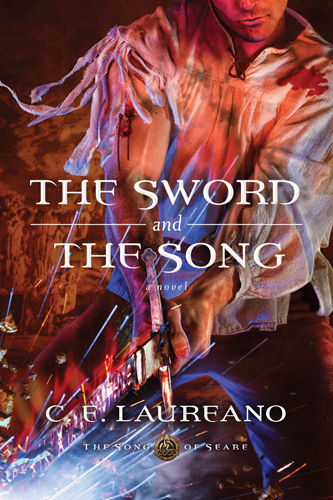I used to define my reading habits by what genres I didn’t read, and sci-fi/fantasy was always on the list. But well-written stories of any kind are finding their way to not just my reading pile but my list of favorites. And C.E. Laureano’s three-book series, The Song of Seare, is a prime example.
 I just finished the third book, The Sword and the Song, and I’m stunned. (Disclaimer: I received a free copy of the book through the Tyndale Blog Network.)
I just finished the third book, The Sword and the Song, and I’m stunned. (Disclaimer: I received a free copy of the book through the Tyndale Blog Network.)
Throughout my reading of this series, I’ve written about how surprised I was at how much I liked it. (Read my previous review here.) I didn’t grow up reading the Lord of the Rings series, although I did read The Chronicles of Narnia once upon a time, but I’m rediscovering a love for this kind of faith-based action adventure series set in a world of the author’s imagining.
Laureano’s world is reminiscent of Celtic culture, namely Ireland, and I want to literally applaud her for the names of people and countries that she invented to sound like Irish names but not quite.
But let’s talk about this final book for a moment, and the series as a whole. I did not see the end coming, and it was so surprising that it brought me to tears. You can read a short interview with the author, below, and she talks about some of her decisions in the series. Let me just say this: you will want to throw the book–any of them–across the room because Laureano does not play by the “everyone must be happy all the time” rule. (Is that a rule at all?) Her characters go through realistic drama that tears their worlds apart, but through it all, a thread of hope remains.
I’m sad to see this series end, and if I could ask the author one question myself it would be: Is this really the end?
 Here are a few more questions Laureano answered about the series:
Here are a few more questions Laureano answered about the series:
Why Celtic fantasy?
I’ve been interested in Ireland for as long as I can remember, maybe because of my distant Irish heritage. I had the opportunity to travel there during college, and I’ve never felt such an instant affinity for a place. While America will likely always be the place I “hang my hat”, I realized that Ireland was my heart’s home. Ever since then, I’ve written Irish characters and settings. But it was only when I started reading books by Juliet Marillier—wonderful historical fantasies that showed the pagan/Christian conflict from the pagan point of view—I knew I wanted to do something similar with a Christian slant.
How much is based on history and how much was made up?
The culture of Seare is very much based on ancient Ireland before the 10th century, but since relatively little is known about that time period, much of it is extrapolated from research done in the 1920’s. (Some of that research, like the idea that the Irish wore kilts, has since been disproven.) But the food, weaponry, law, and social structure of Seare is very similar to how things might have been in ancient Ireland. Of course, the addition of magic changes things, so I got to imagine how the existence of supernatural gifts and blood magic might have affected their culture. I also re-envisioned the faerie mythology from a neutral, mischievous role into something more malevolent.
What do you hope readers will take away from your books?
I didn’t want to write a “safe” story where you know that everything is going to be okay and everyone will come out unharmed—because real life isn’t like that. It can be scary and messy and unpredictable. But through it all, if you look hard enough, is the ever-present thread of God’s grace and provision. My greatest wish is that readers come away with the understanding that they have a purpose, that they matter, that God cares for them as individuals and not just as a face in the crowd. I’ll consider my job done if readers walk away with hope.
Visit Laureano’s website to find out more about her and her writing. Books in this series are: The Oath of the Brotherhood, Beneath the Forsaken City and The Sword and the Song. I hope there is more like this series to come from Laureano!
